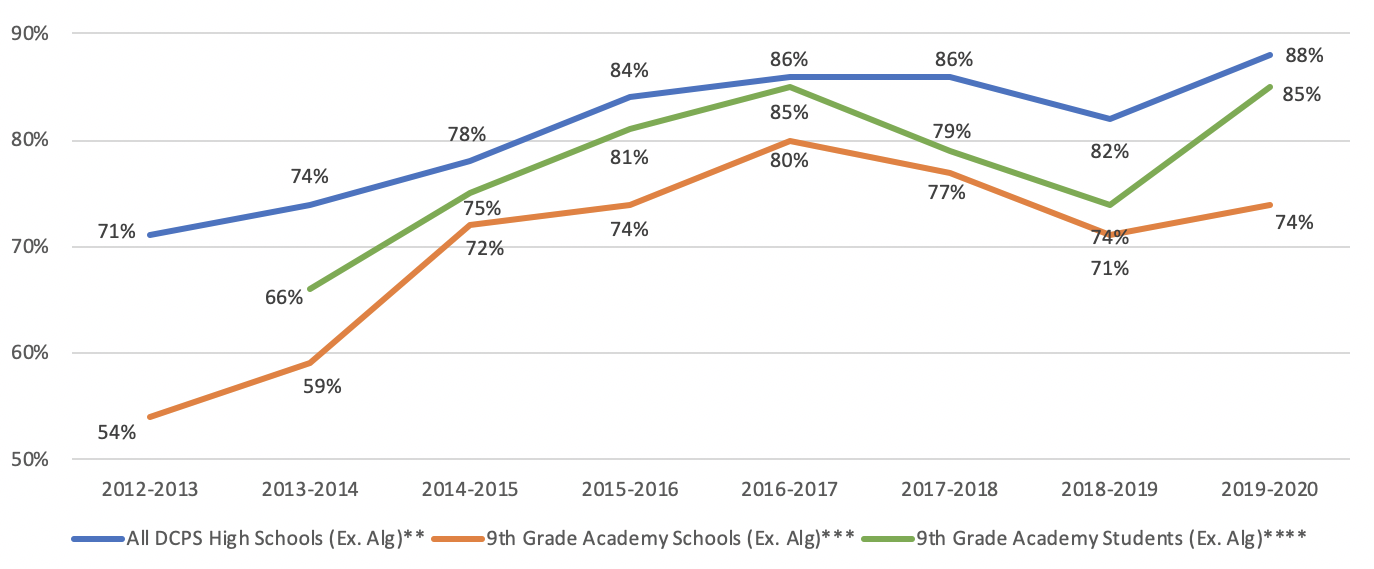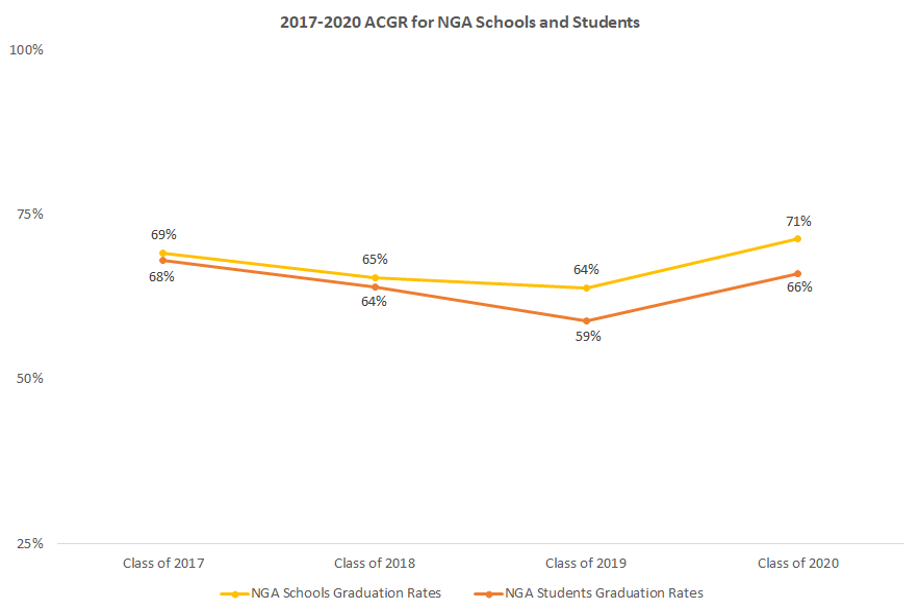The Ninth Grade Academies support first time ninth grade students’ successful transition to high school, provide clear expectations and consistent adult practices, and ensure frequent feedback with a network of social, emotional, and academic personalized interventions.
Ninth Grade Academies were established in School Year 2013-2014 in response to a 54 percent 9th grade promotion rate in comprehensive high schools in School Year 2012-2013, which was 17 percent below the promotion rate for all 9th graders. Research shows that students who promote to the 9th grade in one year have an 81% chance of graduating from high school in four years; those who do not promote have only a 22% chance of graduating, ever (Phillips, 2019). Therefore, the Ninth Grade Academies were introduced as a strategy to increase promotion rates and success at all grade levels, and to increase four-year graduation rates. It started in eight schools, serving 989 students. Eight years later in School Year 2020-21, Ninth Grade Academies are in nine schools, serving 1035 students: Anacostia, Ballou, Cardozo, Coolidge, Dunbar, Eastern, Ron Brown, Roosevelt, and Woodson.
District of Columbia Public Schools continuously develop Ninth Grade Academies by applying the findings of research:
- District leadership is committed to developing Ninth Grade Academies, with champions in positions of authority at multiple levels, coordinating messages consistently and clearly to school leaders.
- Technical and financial support to ninth grade academies is consistent and constructive.
- DCPS is dedicated to the ongoing improvement of ninth grade curriculum, instruction, assessment, and social-emotional-academic student support structures and strategies.
- DCPS maintains dedicated ninth grade faculties led by a single administrator.
- Academies receive the specific guidelines, on-site support, on-ongoing professional learning, resources, and tools to implement and increase effectiveness of multiple academy components, over time, in nine comprehensive high schools.
(Legters, Parise and Rappaport, 2013)
Ninth Grade Academy students are first year 9th graders scheduled in teams with a team of teachers; the team of teachers share the same students. The teachers become experts on the students, meeting weekly to analyze data and strategize, and enjoying personalized professional learning in consultation with their academy AP. Academy APs meet monthly with each other to share effective practices and provide mutual support, and enjoy ongoing, job-embedded leadership development in consultation with the Director of Ninth Grade Academies. The Director and Central Coordinator of Ninth Grade Academies manage the program, budget, and data reports, providing on track to promote rates and more, weekly.
Academy teacher gradebooks are updated frequently and monitored closely, triggering engagement and/or academic interventions for students who are off track to promote. Academies offer after-school tutoring, Saturday School, and ongoing counseling to help students complete their success plans.
Results:
On-time 9th grade promotion rates (first time 9th graders only)

**Data is for all first-time ninth grade students enrolled in Algebra I and English I at the Academy high schools (excludes certain ELL students). Students promote to tenth grade by passing English I and earning at least 6 credits.
***Academy schools’ data includes all first year ninth graders in that school, both inside and out of academies.
****The business rules for defining academy students have been clarified and differ from those originally used in SY13-14. As of SY17-18, Algebra I is no longer a prerequisite to promote to the 10th grade, therefore data is changed from originally reported by providing data both including and excluding Algebra I.
Graduation rates starting with the Class of 2017, the first to include academy students

Note. This graph reports adjusted cohort graduation rates (ACGR) for NGA schools and NGA students in 2017-2020. NGA students’ graduation rates are calculated based on students who participated in NGA in SY13-14, 14-15, 15-16, and 16-17 and were included in the 2017, 2018, 2019, and 2020 ACGR cohorts, respectively, regardless of their cohort responsible school.


